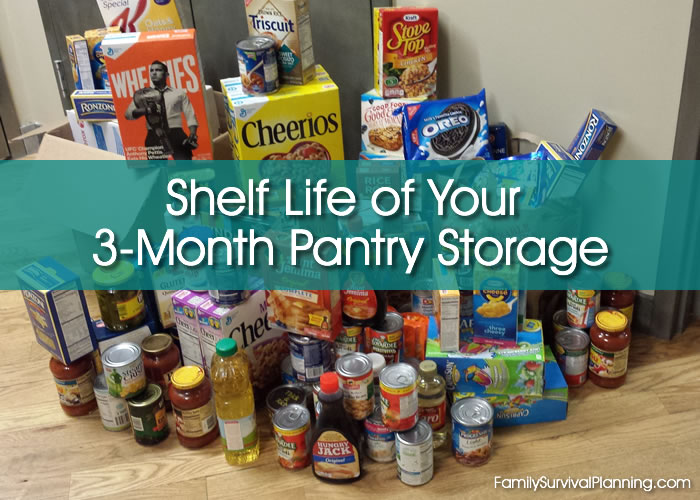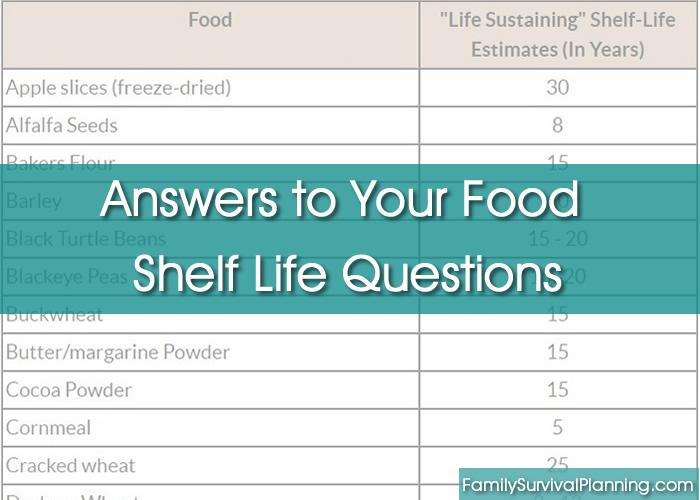
- HOME
- Food Storage Guidelines
- Food Shelf Life
Shelf Life of Your
3-Month Pantry Storage

In order to stock your pantry for three months or longer, you need to know each food product's shelf life or "best if used by" information (more about this in a minute).
The length of the shelf life of food depends on the type of food, packaging, storage temperature, and humidity. (More information on the shelf life of long term food storage products.)
Invest in emergency food storage now and enjoy peace of mind for the next 25 years. Don't miss out on the savings!
Using good "shelf life" practices has terrific advantages.
- Instead of running to the store because you're out of some food in the middle of a recipe, you can go to your storage room or pantry and grab what you need.
- You can usually avoid paying full price for most food products — replace it next time there's a sale.
- Avoid being tempted to impulse-buy. (Happens to the best of us when we are at the store too frequently.)
Proper Storage Conditions
Food will spoil due to the growth of microorganisms. Oxygen destroys food over time (thus the need for air-tight storage over the long term). Foods, such as dairy products, meats, poultry, eggs, and fresh fruits and vegetables, will spoil very quickly if not stored at proper temperatures.
For optimal quality and safety, store:
- Dairy products at refrigerated temperatures between 34°F and 38°F;
- Meats between 33°F and 36°F;
- Eggs 33°F to 37°F;
- Fresh vegetables and ripe fresh fruits between 35°F and 40°F.
Always store refrigerated foods at temperatures less than 40°F. Use a thermometer in the refrigerator to monitor the temperature often. This is especially important during the hot summer months.
We purchased this little Indoor/Outdoor Thermometer with Probe, one each for our refrigerator and freezer. The cool thing about his thermometer is the probe.
It goes inside the refrigerator or freezer, while the thermometer is outside. It gives you the temperature on the inside, as well as the room temperature. You can monitor the inside temperature without opening the refrigerator or freezer.
Frozen Foods

Frozen foods should be stored below 0°F in moisture-proof, gas-impermeable plastic or freezer wrap. Be sure to label and date frozen foods. Frozen foods may be safe to eat if stored longer than the recommended storage time but quality may diminish.
Be careful not to overload your freezer and block the circulation of coolant. This will cause your freezer to be less efficient, making it difficult to keep the food below 0°F.
Dry Food Staples

Dry food staples such as flour, crackers, cake mixes, seasonings, and canned goods should be stored in their original packages or airtight containers below 85°F (optimum 50°F to 70°F). Humidity levels higher than 60% may cause dry foods to accumulate moisture causing spoilage. Canned goods stored in high humidity areas may ultimately rust, resulting in leaky cans. Discard canned goods that are swollen, badly dented, rusted, and/or leaking.
For safety, always store food separate from nonfood items such as paper products, household cleaners, and insecticides. Contamination of food or eating utensils with a household cleaner or insecticide could result in a chemical poisoning.
Breads, Cereals, Flour and Rice

- Bread food shelf life is 5 to 7 days if stored in the original package at room temperature. However, bread stored in the refrigerator will have a longer shelf-life due to delayed mold growth and may be firmer. Expect a 2- to 3-month shelf-life of bread stored in the freezer.
- Refrigerate cream style bakery goods containing eggs, cream cheese, whipped cream and/or custards no longer than 3 days.
- Cereals may be stored at room temperature in tightly closed containers to keep out moisture and insects.
- Whole wheat flour may be stored in the refrigerator or freezer to retard rancidity of the natural oils. Store whole wheat flour in the freezer for about a week to kill off any weevil eggs that might be in it.
- Store raw white rice in tightly closed containers at room temperature and use within one year.
- Brown and wild rice stored at room temperature will have a shorter shelf-life (6 months) due to the oil becoming rancid. Shelf-life of raw white and brown rice may be extended by refrigeration. Cooked rice may be stored in the refrigerator for 6 to 7 days or in the freezer for 6 months.
Fresh Vegetables

Removing air (oxygen) from the package, storing the vegetables at 40°F refrigerated temperatures, and maintaining optimum humidity (95 to 100%) may extend the food shelf life of fresh vegetables. Most fresh vegetables may be stored up to 5 days in the refrigerator.
- Always wrap or cover fresh leafy vegetables like spinach and lettuce in moisture-proof bags or a container with a tight lid (like Tupperware) to retain product moisture and prevent wilting.
- Root vegetables (potatoes, sweet potatoes, onions, etc.) and squashes, eggplant, and rutabagas should be stored (unwrapped) in a cool, well-ventilated place between 50°F and 60°F.
- Tomatoes continue to ripen after harvesting and should be stored at room temperature.
- Removing the tops of carrots, radishes, and beets prior to refrigerator storage will reduce loss of moisture and extend shelf-life.
- Palatability of corn diminishes during cold storage due to elevated starch content. Corn and peas should be stored in a ventilated container.
Processed Vegetables

- Canned vegetables can be stored in a cool, dry area below 85°F (optimum 50°F to 70°F) for up to one year. After one year, canned vegetables may still be consumed. However, overall quality and nutritional value may have diminished. Discard badly dented, swollen, and/or rusty cans.
- Frozen vegetables may be stored in the freezer for 8 months at 0°F. Home prepared vegetables should be blanched prior to freezing.
- Dehydrated vegetables should be stored in a cool, dry place and used within 6 months since they have a tendency to lose flavor and color.
Fresh Fruit

In general, store fresh fruit in the refrigerator or in a cold area to extend the food shelf life. Reduce loss of moisture from fresh fruit by using, covered containers. Always store fresh fruit in a separate storage area in the refrigerator, since fresh fruits may contaminate or absorb odors from other foods.
Prior to eating, rinse fresh fruits and vegetables to remove possible pesticide residues, soil, and/or bacteria.To remove most of the pesticides on the outside of produce, use 25% white vinegar to 75% water. Let soak for 30-60 minutes. (Do not soak berries as they will absorb too much vinegar.) Peeling, followed by washing of fresh fruits and vegetables, is also very efficient in removing residues.
- Ripe eating apples should be stored separately from other foods in the refrigerator and eaten within one month. Apples stored at room temperature will soften rapidly within a few days. Remember to remove apples that are bruised or decayed prior to storage in the refrigerator. Do not wash apples prior to storage.
- Green pears and apricots should be ripened at room temperature and then stored in the refrigerator. Expect a 5-day refrigerated shelf-life for these fruits.
- Unripe peaches may be ripened at room temperature and eaten after 2 days. Store ripe peaches in the refrigerator but consume at room temperature.
- Grapes and plums should be stored in the refrigerator and eaten fresh within 5 days of purchase. Store unwashed grapes separately from other foods in the refrigerator and wash prior to consumption.
- Ripe strawberries can be stored in the refrigerator separately from other foods for approximately 3 days. Strawberries should be washed and stemmed prior to consumption.
- Citrus fruits, such as lemons, limes, and ripened oranges, can be stored in the refrigerator for 2 weeks. Grapefruit may be stored at a slightly higher temperature of 50°F.
- Melons, such as the honeydew melon, cantaloupe, and watermelon, may be ripened at room temperature for 2, 3, and 7 days, respectively. Store ripe melons in the refrigerator.
- Avocados and bananas should be ripened at room temperature for 3 to 5 days. Never store unripe bananas in the refrigerator, since cold temperatures will cause the bananas to rapidly darken.
Processed Fruit

- Canned fruit and fruit juices may be stored in a cool, dry place below 85°F (optimum 50°F to 70°F) for one year. As with canned vegetables, badly dented, bulging, rusty, or leaky cans should be discarded.
- Dried fruits have a long shelf-life because moisture has been removed from the product. Unopened dried fruits may be stored for 6 months at room temperature.
Dairy Products

- The shelf-life of fresh milk stored in the refrigerator (<40°F) will range from 8 to 20 days depending upon the date of manufacture and storage conditions in the grocer's shelf. Milk is a very nutritious and highly perishable food. Milk should never be left at room temperature and always capped or closed during refrigerator storage. Freezing milk is not recommended, since the thawed milk easily separates and is susceptible to development of off-flavors.
- Dry milk may be stored at cool temperatures (50°F to 60°F) in airtight containers for one year. Opened containers of dry milk, especially whole milk products, should be stored at cold temperatures to reduce off-flavors. Handle reconstituted milk like fresh milk and store at refrigeration temperatures if not immediately used.
- Canned evaporated milk and sweetened condensed milk may be stored at room temperature for 12 to 23 months. Refrigerate opened canned milk and consume within 8 to 20 days.
- Natural and processed cheese should be kept tightly packaged in moisture-resistant wrappers and stored below 40°F. Surface mold growth on hard natural cheese may be removed with a clean knife and discarded. Re-wrap cheese to prevent moisture loss. Presence of mold growth in processed cheese, semi-soft cheese, and cottage cheese is an indicator of spoilage and thus these foods should be discarded. Vacuum packaging hard cheeses will greatly prolong its shelf life.
- Store commercial ice cream at temperatures below 0°F. Expected shelf-life of commercial ice cream is approximately 2 months before quality diminishes. Immediately return opened ice cream to the freezer to prevent loss of moisture and development of ice crystals. Store ice cream at constant freezer temperatures to slow growth of ice crystals.
Meats, Poultry, Fish, and Eggs

- Meat, poultry, fish, and eggs are highly perishable and potentially hazardous due to their high moisture and high protein content. Generally, fresh cuts of meat contain spoilage bacteria on the surface that will grow, produce slime, and cause spoilage after 3 days of refrigerator storage in oxygen-permeable packaging film. To be safe, cook fresh meat within 24 hours.
- Ground meat products are more susceptible to spoilage due to the manufacturing process and increased surface area of the product. Bacteria in ground meats are distributed throughout, providing rapid growth in the presence of air. Ground meats should be stored on the lower shelf of the refrigerator and used within 24 hours of purchase. Refrigerator storage slows bacterial growth; however, the product will eventually spoil. Optimum storage temperature of refrigerated meats, including ground beef, is 33°F to 36°F. Freezing ground meat increases its shelf life to 3-6 months.
Vacuum packaging before freezing greatly extends shelf life and prohibits freezer burn. - Whole cuts of meat may be stored in the freezer ranging from 4 to 12 months. For maximum storage, vacuum pack meats in moisture-proof, gas impermeable packaging to prevent freezer burn.
- Cured meats, such as bacon, should be stored in their original packaging in the refrigerator. Cured meats have a tendency to become rancid when exposed to air. Therefore, re-wrap cured meats after opening the package. Expect approximately a 1-week shelf-life for cured meats. Vacuum-packaging (absence of air) and modified atmospheric packaging (partial removal of air) extends shelf-life of meats and meat products (i.e. luncheon meats). The shelf-life of vacuum-packaged meats and gas-flushed meats is 14 days and 7 to 12 days, respectively.
- Poultry should be prepared within 24 hours of purchase or stored in the freezer. Poultry may be stored in the freezer (0°F) for 12 months. Thaw poultry in the refrigerator, under cold running water, or in the microwave. Cook poultry parts (i.e. breast and roast) and whole poultry to an internal temperature of 170°F, and 180°F, respectively. Leftovers stored in the refrigerator should be consumed within 3 days and reheated to 165°F prior to consumption. Poultry broth and gravy should not be stored more than 2 days in the refrigerator and reheated to a full boil (212°F) before consuming.
- Fresh fish, shrimp, and crab stored in the refrigerator (slightly above 32°F) should be consumed within 1 to 2 days. Never store fresh fish in water due to leaching of nutrients, flavor, and pigments. Frozen fresh lean fish and seafood (except shrimp) may be stored for 3 to 6 months at 0°F. Shrimp may be stored for 12 months at 0°F.
- Eggs should be purchased refrigerated and stored in the refrigerator (33°F to 37°F) in their original carton. Storage of eggs in the original carton reduces absorption of odors and flavors from other foods stored in the refrigerator. Use eggs within 3 to 5 weeks of the "pack date" listed on the carton. Leftover egg yolks and egg whites may be stored in the refrigerator covered for 2 and 4 days. Cover egg yolks with water. Hard-boiled eggs may be stored in the refrigerator for 1 week, whereas pasteurized liquid eggs may be stored in the refrigerator for 10 days. Egg whites and pasteurized eggs may be stored at freezer temperatures for one year. Shell eggs should never be stored in the freezer. Dried eggs may be stored in tightly closed containers in the refrigerator for one year.
Using these shelf life guidelines for safe food storage will save you money in the long run. All it takes is a little planning.
















